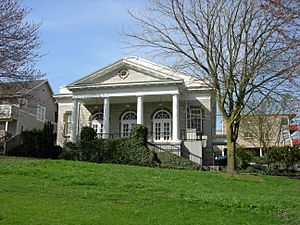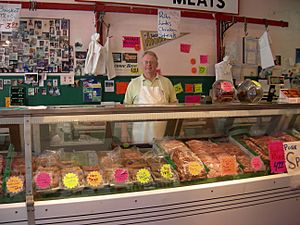Columbia City, Seattle facts for kids
Quick facts for kids
Columbia City
|
|
|---|---|
|
Seattle Neighborhood
|
|
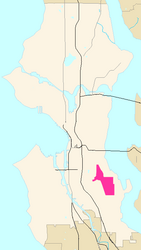
Map of Columbia City's location in Seattle
|
|
| Country | United States |
| State | Washington |
| City | Seattle |
| City Council | District 2 |
| Neighborhood Council | Southeast District |
| Police District | South Precinct, R3 |
| Established | Incorporated in 1893 and Annexed to Seattle in 1907 |
| Founded by | J. K. Edmiston |
| Named for | Christopher Columbus |
| Population | |
| • Total | 13,031 |
| ZIP code |
98118
|
Columbia City is a lively neighborhood in southeastern Seattle, Washington. It's part of the city's Rainier Valley area. This neighborhood has a special historic business district that is protected. It is also known for having a mix of different cultures and people for a long time.
You can find Columbia City by looking for Rainier Avenue S. and Martin Luther King Jr. Way S. These are the main roads running north and south. For east and west, look for S. Alaska Street, S Orcas Street, and S. Genesee Street. Getting around is easy with Sound Transit's Central Link light rail. The Columbia City station can take you to downtown Seattle in about 15 minutes or to SeaTac airport in 20 minutes.
Contents
Exploring Columbia City's Past
How Columbia City Began
Long ago, this area was a thick forest filled with tall trees. Coast Salish peoples lived here before others arrived. In 1891, the Rainier Valley Electric Railway came from Downtown Seattle. The railway owners bought land, built a lumber mill, and cleared the area for homes. They called their new town "Columbia," named after the explorer Christopher Columbus.
Some streets in the neighborhood are also named after famous explorers. Ferdinand Street is named after Magellan. Hudson Street is for Henry Hudson, and Americus Street honors Amerigo Vespucci. When the first plots of land were sold in 1891, people gathered under a canvas tent. The railway cars had a slogan: "Columbia, Watch It Grow!"
Columbia officially became "Columbia City" in January 1893. Later, on May 3, 1907, it joined the larger City of Seattle. Citizens asked the City Council to hold a special vote on this. Even though some people wanted to keep local control, the vote on March 5 was very clear: 109 people voted to join Seattle, and only 3 voted against it.
In 1905, the Seattle Renton & Southern Railway extended its line south to Renton. This railway later became the Seattle & Rainier Valley Railway. Its last trip was on January 1, 1937. Columbia City also hoped to become a seaport (a city with a port for ships). But this dream ended when the Lake Washington Ship Canal was finished in 1917. The canal lowered Lake Washington by nine feet. This caused Wetmore Slough, a watery area, to dry up. This former slough was used as a dump for many years. Today, it is Genesee Park, a green space for everyone.
A big employer in the early days was the Hitt Fireworks Company. It operated from 1905 to the 1960s. This company was located where Hitt's Hill Park is now. In the 1930s, about 200 people worked there. They were famous for creating amazing firework shows at world's fairs and Fourth of July celebrations. During World War II, they made smoke screens and parachute flares for the war effort. The Hitt Fireworks Company even made special effects for movies, like Gone with the Wind.
Columbia City's Growth and Changes
Over time, many African Americans moved to Seattle for jobs during wartime. Many settled in the Columbia City area. By the 1970s, the neighborhood faced challenges. Many shops along Rainier Avenue S. were empty.
To help the area, the Columbia City business district was added to the National Register of Historic Places in 1980. This means its historic buildings are protected. This district stretches north to S. Alaska Street and south to the intersection of 39th Ave S and Rainier Ave S. It goes east to 39th Ave S. and west to the alley east of 35th Ave S.
Starting in the late 1980s, many new people began moving to Columbia City. These included artists and families looking for classic homes at good prices. By the late 1990s, Columbia City was known as one of Seattle's most creative neighborhoods. In recent years, property values have increased a lot. This has led to many older homes being fixed up and new condos being built. Today, Columbia City is known for its mix of people from different backgrounds and income levels. It has everything from public housing to beautiful homes with great views.
Life in Columbia City Today
Today, the main business area along Rainier Avenue S. is very busy. You can find many places to eat, like restaurants and bakeries. There are also coffee shops, stores, art galleries, and places to exercise. The neighborhood has a movie theater and several spots for live music.
You'll see different types of homes here. There are classic craftsman bungalows and a mix of apartment buildings. Many new townhomes are also being built, often on land that was empty before. It's estimated that at least 1,500 new homes are planned for the area.
The Link Light Rail station opened in July 2009. This train service makes it easy to get to SeaTac airport and Downtown Seattle. Rainier Vista, which was once a public housing project, has been rebuilt. It's now a community with different types of homes and incomes. It has over 900 new homes, some for rent and some for purchase, all built around the light rail station.
Community Groups and Fun Activities
Columbia City has many groups that help the community. Bike Works is a charity where kids can earn bikes by learning how to fix them. The Boys and Girls Club has a new center here. Genesee Park is a large park with a playfield. It is also home to the Rainier Valley Community Center.
The Rainier Arts Center and Southside Commons are places for art and cultural events. The Rainier Valley Historical Society helps people learn about the area's past. The SouthEast Economic Development organization helps with affordable housing and supports local businesses and arts. They also help run the Columbia City Gallery and the Rainier Arts Center.
Festivals and Events to Enjoy
Columbia City hosts many fun events throughout the year. The Rainier Valley Heritage Parade and Summer Streets Party happens every August. Beatwalk is a series of live music performances in the Historic District. You can enjoy music on the streets and in local businesses from June to September.
A farmer's market runs from May to mid-October along S Edmunds St. Many neighbors gather for a picnic dinner in nearby Columbia Park during market days. HONK! Fest West is a lively music festival that takes place the first weekend of June. It features street bands performing in public spaces, making music accessible to everyone.
Historic Places in Columbia City
Several buildings and areas in Columbia City are listed on the National Register of Historic Places. This means they are important parts of history and are protected.
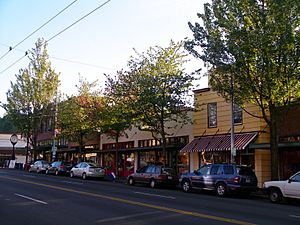 |
Columbia City Historic District (Seattle, Washington) | This historic area includes shops and buildings. It stretches from S. Alaska Street in the north to 39th Ave S and Rainier Ave S in the south. It goes east to 39th Ave S. and west to the alley east of 35th Ave S. It was added to the list in 1980. |
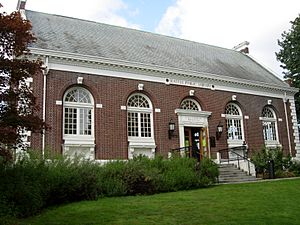 |
Seattle Public Library - Columbia City Branch | This library was built in 1915 with money from Andrew Carnegie. You can find it in Columbia Park at 4721 Rainier Avenue S. It was added to the list in 1982. |


